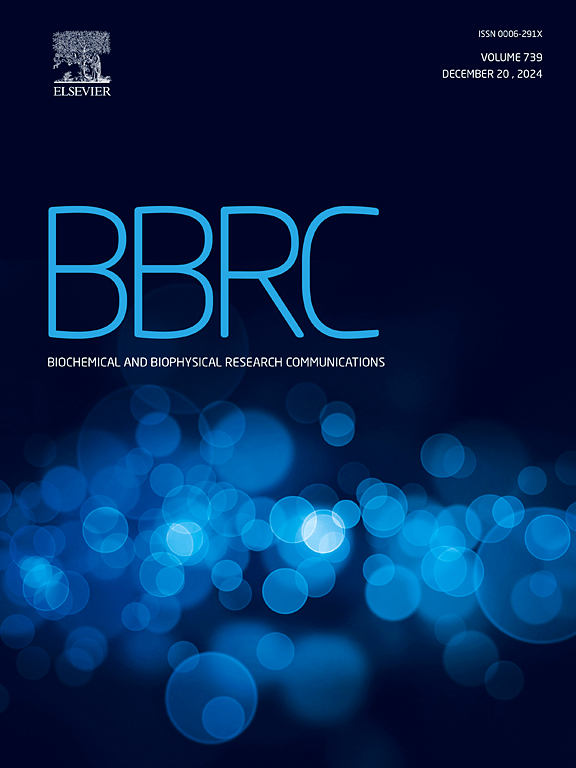超声靶向微泡破坏介导的CNN1上调通过调节p53相关SLC7A11的表达诱导结直肠癌细胞铁凋亡
IF 2.5
3区 生物学
Q3 BIOCHEMISTRY & MOLECULAR BIOLOGY
Biochemical and biophysical research communications
Pub Date : 2025-06-13
DOI:10.1016/j.bbrc.2025.152207
引用次数: 0
摘要
结直肠癌(CRC)是癌症相关死亡的主要原因,患者对当前治疗方式的反应往往不理想,这强调了创新治疗方法的必要性。超声靶向微泡破坏(UTMD)是一种很有前途的提高基因转染效率的技术。虽然先前的研究已经确定了CyclinD1 (CNN1)在多种癌症类型的发病机制中的关键作用,但其在CRC进展中的作用仍未得到充分研究。在这项研究中,我们试图阐明utmd介导的CNN1调节对CRC进展的影响。在本研究中,数据表明CNN1在CRC中表达不足,并可能促进CRC的进展。与脂质体(LIP)介导的转染相比,utmd辅助转染CNN1的效率显著提高。utmd介导的CNN1过表达可有效抑制结直肠癌细胞增殖,促进细胞凋亡。机制研究表明,utmd驱动的encnn1过表达通过p53信号通路抑制结直肠癌细胞增殖。进一步研究证实,SLC7A11在结直肠癌组织中过表达,而CNN1过表达下调SLC7A11的表达。值得注意的是,p53通过直接结合SLC7A11的启动子区域来抑制SLC7A11的转录。救援实验表明,utmd介导的CNN1过表达通过激活p53-SLC7A11通路诱导铁凋亡。总的来说,utmd驱动的CNN1上调通过调节p53相关的SLC7A11表达引发CRC细胞铁凋亡。这些发现突出了CNN1作为CRC治疗干预和诊断策略的潜在靶点。本文章由计算机程序翻译,如有差异,请以英文原文为准。
Ultrasound-targeted microbubble destruction mediated upregulation of CNN1 induces ferroptosis in colorectal cancer cells by regulating p53-related SLC7A11 expression
Colorectal cancer (CRC) represents a leading cause of cancer-related mortality, with patients often demonstrating suboptimal responses to current therapeutic modalities, underscoring the need for innovative treatment therapies. Ultrasound-targeted microbubble destruction (UTMD) has emerged as a promising technique to enhance gene transfection efficiency. While previous research has established the critical role of CyclinD1 (CNN1) in the pathogenesis of multiple cancer types, its involvement in CRC progression remains underinvestigated. In this study, we sought to elucidate the impact of UTMD-mediated CNN1 modulation on CRC progression. In the present study, data indicate that CNN1 is underexpressed in CRC and may contribute to CRC progression. UTMD-assisted transfection of CNN1 exhibits significantly higher efficiency compared to liposomes (LIP)-mediated transfection. UTMD-mediated CNN1 overexpression potently inhibits CRC cell proliferation and promotes cell apoptosis. Mechanistic investigations reveal that UTMD-drivenCNN1 overexpression suppresses CRC cell proliferation via the p53 signaling pathway. Further studies confirm that SLC7A11 is overexpressed in CRC tissues, whereas CNN1 overexpression downregulates SLC7A11 expression. Notably, p53 inhibits SLC7A11 transcription by directly binding to its promoter region. Rescue experiments demonstrate that UTMD-mediated CNN1 overexpression induces ferroptosis through activation of the p53-SLC7A11 pathway. Collectively, UTMD-driven upregulation of CNN1 elicits ferroptosis in CRC cells by modulating p53-associated SLC7A11 expression. These findings highlight CNN1 as a potential target for therapeutic intervention and diagnostic strategies in CRC.
求助全文
通过发布文献求助,成功后即可免费获取论文全文。
去求助
来源期刊
CiteScore
6.10
自引率
0.00%
发文量
1400
审稿时长
14 days
期刊介绍:
Biochemical and Biophysical Research Communications is the premier international journal devoted to the very rapid dissemination of timely and significant experimental results in diverse fields of biological research. The development of the "Breakthroughs and Views" section brings the minireview format to the journal, and issues often contain collections of special interest manuscripts. BBRC is published weekly (52 issues/year).Research Areas now include: Biochemistry; biophysics; cell biology; developmental biology; immunology
; molecular biology; neurobiology; plant biology and proteomics

 求助内容:
求助内容: 应助结果提醒方式:
应助结果提醒方式:


